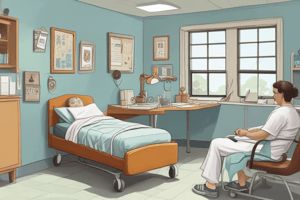Podcast
Questions and Answers
Which of the following is the first step in patient management?
Which of the following is the first step in patient management?
- Assessing airway patency, breathing, circulation, and level of consciousness
- Performing the primary survey by assessing the patient's general appearance and degree of distress (correct)
- Reassessing vital signs every 30 minutes
- Determining the patient's symptoms, allergies, past medical history, and medications
What is the purpose of determining the patient's history?
What is the purpose of determining the patient's history?
- To reassess vital signs every 30 minutes
- To assess the patient's general appearance and degree of distress
- To ensure scene safety
- To determine the patient's symptoms, allergies, past medical history, and medications (correct)
Which vital signs should be assessed as part of the baseline assessment?
Which vital signs should be assessed as part of the baseline assessment?
- Heart rate, respiration rate, blood pressure, and pulse oximetry (correct)
- Blood pressure, pulse oximetry, Glasgow coma scale, and pupils
- Heart rate, respiration rate, blood pressure, and Glasgow coma scale
- Respiration rate, blood pressure, pulse oximetry, and pupils
When should vital signs be reassessed?
When should vital signs be reassessed?
What does VSA stand for?
What does VSA stand for?
Immediately on patient contact perform the primary survey by assessing airway patency, breathing, circulation and level of consciousness (AVPU)- look for obvious injury and hemorrhage - when or if finding absent/inadequate airway, breathing, circulation- follow Patient Management standard-
Immediately on patient contact perform the primary survey by assessing airway patency, breathing, circulation and level of consciousness (AVPU)- look for obvious injury and hemorrhage - when or if finding absent/inadequate airway, breathing, circulation- follow Patient Management standard-
Determine patient history - determine patient symptoms, allergies, past medical history and medications (sample) - Baseline Vital signs: Heart rate, Respiration rate, blood pressure (BP), Pulse oximetry (SPO2), Glasgow coma scale (GCS), pupils and skin colour and condition. - All vitals signs absent (VSA) - Cerebrovascular accident (CVA) - reassess vital sign relevant to patients condition, every 30 minutes at a minimum.
Determine patient history - determine patient symptoms, allergies, past medical history and medications (sample) - Baseline Vital signs: Heart rate, Respiration rate, blood pressure (BP), Pulse oximetry (SPO2), Glasgow coma scale (GCS), pupils and skin colour and condition. - All vitals signs absent (VSA) - Cerebrovascular accident (CVA) - reassess vital sign relevant to patients condition, every 30 minutes at a minimum.
- Make scene observation relevant to the patients status- scene safety. - immediately on patient contact perform the primary survey by,, - the patients general appearance, degree of distress, and CTAS - ensuring C-spine precautions - ______- look for obvious injury and hemorrhage - when or if finding absent/inadequate airway, breathing, circulation- follow Patient Management standard- - Determine patient history - determine patient symptoms, allergies, past medical history and medications (sample) - Baseline Vital signs: Heart rate, Respiration rate, blood pressure (BP), Pulse oximetry (SPO2), Glasgow coma scale (GCS), pupils and skin colour and condition. - All vitals signs absent (VSA) - Cerebrovascular accident (CVA) - reassess vital sign relevant to patients condition, every 30 minutes at a minimum.
- Make scene observation relevant to the patients status- scene safety. - immediately on patient contact perform the primary survey by,, - the patients general appearance, degree of distress, and CTAS - ensuring C-spine precautions - ______- look for obvious injury and hemorrhage - when or if finding absent/inadequate airway, breathing, circulation- follow Patient Management standard- - Determine patient history - determine patient symptoms, allergies, past medical history and medications (sample) - Baseline Vital signs: Heart rate, Respiration rate, blood pressure (BP), Pulse oximetry (SPO2), Glasgow coma scale (GCS), pupils and skin colour and condition. - All vitals signs absent (VSA) - Cerebrovascular accident (CVA) - reassess vital sign relevant to patients condition, every 30 minutes at a minimum.
- Make scene observation relevant to the patients status- scene safety. - immediately on patient contact perform the primary survey by,, - the patients general appearance, degree of distress, and CTAS - ensuring C-spine precautions - assessing airway patency, breathing, circulation and level of consciousness (AVPU)- ______ - when or if finding absent/inadequate airway, breathing, circulation- follow Patient Management standard- - Determine patient history - determine patient symptoms, allergies, past medical history and medications (sample) - Baseline Vital signs: Heart rate, Respiration rate, blood pressure (BP), Pulse oximetry (SPO2), Glasgow coma scale (GCS), pupils and skin colour and condition. - All vitals signs absent (VSA) - Cerebrovascular accident (CVA) - reassess vital sign relevant to patients condition, every 30 minutes at a minimum.
- Make scene observation relevant to the patients status- scene safety. - immediately on patient contact perform the primary survey by,, - the patients general appearance, degree of distress, and CTAS - ensuring C-spine precautions - assessing airway patency, breathing, circulation and level of consciousness (AVPU)- ______ - when or if finding absent/inadequate airway, breathing, circulation- follow Patient Management standard- - Determine patient history - determine patient symptoms, allergies, past medical history and medications (sample) - Baseline Vital signs: Heart rate, Respiration rate, blood pressure (BP), Pulse oximetry (SPO2), Glasgow coma scale (GCS), pupils and skin colour and condition. - All vitals signs absent (VSA) - Cerebrovascular accident (CVA) - reassess vital sign relevant to patients condition, every 30 minutes at a minimum.
- Make scene observation relevant to the patients status- scene safety. - immediately on patient contact perform the primary survey by,, - the patients general appearance, degree of distress, and CTAS - ______ - assessing airway patency, breathing, circulation and level of consciousness (AVPU)- look for obvious injury and hemorrhage - when or if finding absent/inadequate airway, breathing, circulation- follow Patient Management standard- - Determine patient history - determine patient symptoms, allergies, past medical history and medications (sample) - Baseline Vital signs: Heart rate, Respiration rate, blood pressure (BP), Pulse oximetry (SPO2), Glasgow coma scale (GCS), pupils and skin colour and condition. - All vitals signs absent (VSA) - Cerebrovascular accident (CVA) - reassess vital sign relevant to patients condition, every 30 minutes at a minimum.
- Make scene observation relevant to the patients status- scene safety. - immediately on patient contact perform the primary survey by,, - the patients general appearance, degree of distress, and CTAS - ______ - assessing airway patency, breathing, circulation and level of consciousness (AVPU)- look for obvious injury and hemorrhage - when or if finding absent/inadequate airway, breathing, circulation- follow Patient Management standard- - Determine patient history - determine patient symptoms, allergies, past medical history and medications (sample) - Baseline Vital signs: Heart rate, Respiration rate, blood pressure (BP), Pulse oximetry (SPO2), Glasgow coma scale (GCS), pupils and skin colour and condition. - All vitals signs absent (VSA) - Cerebrovascular accident (CVA) - reassess vital sign relevant to patients condition, every 30 minutes at a minimum.
Flashcards are hidden until you start studying




